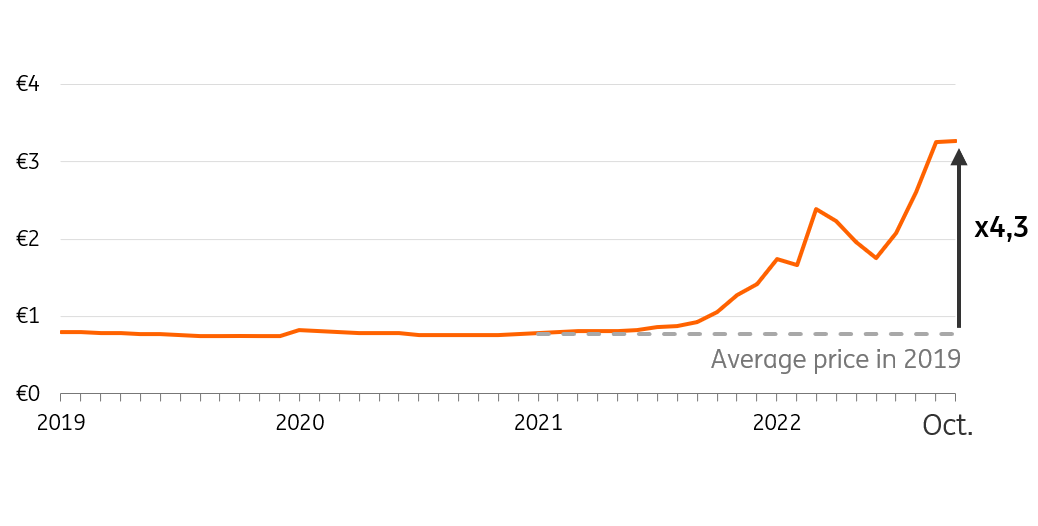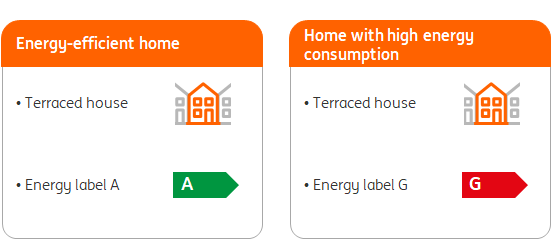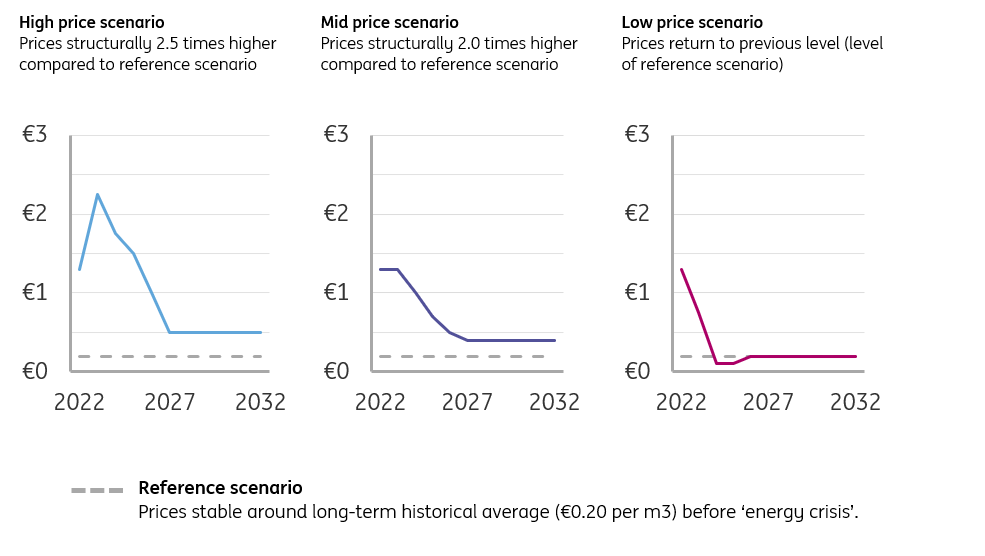The cost of energy efficiency in the Dutch housing market
As energy prices soared in 2022, the gap between energy-efficient homes and those with higher energy consumption widened more than ever. In this article, we look at three key scenarios for the cost advantage of efficient properties moving forward
Higher energy prices have recently increased the cost advantage of energy-efficient homes, which is one of the many reasons why such properties are generally sold at above-average prices. Together with the rise in energy costs, the price differential between energy-efficient homes and those with high energy consumption has also increased. Our scenario analysis shows that this cost advantage could significantly increase if natural gas prices remain structurally high.
In our high-price scenario, the expected cost savings for a terraced house of 130m² would rise to almost 34,000 euro. This is the maximum amount that homebuyers will be willing to offer for an energy-efficient home due to lower natural gas costs. Elevated gas prices could therefore increase the price difference between efficient homes and those with high energy consumption in the longer term.
The cost advantage
Since the beginning of the war in Ukraine, natural gas prices have risen sharply. The consumer price of natural gas averaged around 3.26 euro per m³ in October, compared to an annual average of 0.77 euro in 2019. Higher natural gas prices increase the cost advantage of energy-efficient homes, strengthening their relative attractiveness in the housing market. This seems to be reflected in house prices, as the price gap between energy-efficient homes and homes with high energy consumption has recently widened.
Price of natural gas 4.3 times as high as in 2019
Consumer price of natural gas per month (incl. taxes) in euros per m³

Sales prices for energy-efficient housing
Previous research has shown that energy-efficient homes are sold at a higher price than average compared to those with high energy consumption. The estimated price difference in these studies ranges from about 10,000 euro to over 50,000 euro. Expected savings in energy costs are a key factor here. Other reasons that home buyers are willing to pay more for energy-efficient properties include both the extra comfort of a well-insulated home and the reduced environmental impact of energy consumption.
The ways in which energy prices will develop moving forward still remain very uncertain. To help provide some clarity, we have assessed their potential effect on the cost advantage of energy-efficient homes for three energy price scenarios. In all three scenarios, we calculate the net present value of the cost advantage of an energy-efficient dwelling compared to those with higher levels of energy consumption. The first step is to define what we mean by an energy-efficient home.
Defining an energy-efficient home
We define an energy-efficient home as a well-insulated property with an A-label. The starting point is a terraced house – the most common type of dwelling in the Netherlands – of 130m². Due to the solid insulation, this house consumes relatively little heat. The average natural gas consumption of A-rated dwellings is currently estimated at 7.5 cubic metres of gas (m³) per square meter. This translates into an annual consumption of 975m³ for a terraced dwelling of 130m².
How do we define an energy-efficient home?

The opposite is a home with relatively high gas consumption. We define this as a poorly insulated, G-labeled property. Once again, the starting point is a terraced home of 130m². Due to the poor insulation, this dwelling consumes much more heat. The median natural gas consumption of houses with a G label is estimated to be around 12.9m³ per square meter, 65% more than a similar house with an A label. This translates to an annual consumption of 1,680m³ for a terraced home of 130m².
Three scenarios for energy price uncertainty
Wholesale prices plus energy taxes ultimately determine household natural gas prices. In all three scenarios, we use the tax rates presented on Budget Day 2022 for energy taxes and the recently published rates for the planned energy price cap in 2023.
The three scenarios in our analysis vary in both the number of years that wholesale prices remain high and the long-term average. The evolution of the conflict between Ukraine and Russia is important for short-term price developments, while in the longer term, the energy transition is a more significant factor. The more costly it is to find alternatives to natural gas, the higher energy prices will remain. For the middle scenario, we apply current market expectations (based on current forward market prices). In the low-price scenario, prices fall more quickly than expected, while in the high-price scenario, prices stay elevated for longer and remain structurally higher.
If and when natural gas prices decline to previous levels is uncertain
Three scenarios for the development of wholesale prices for natural gas, in 2023 prices, euro per m3

Even before higher energy prices increased the attractiveness of energy-efficient homes, these properties had a cost advantage. So in order to determine how this trend has actually developed, we need to use a reference scenario. This is a scenario of constant energy prices which shift around the historical long-term average over time (without the sharp rises seen over the last period).
Calculation of the cost advantage
We calculate the cost advantage of an energy-efficient home as the net present value of the expected energy cost savings over time (in the case that home buyers choose this type of property over a dwelling with high gas consumption). We do this for all three energy price scenarios.
Cost advantage increases by more than half in high price scenario
In the reference scenario (with constant energy prices) the net present value of the expected energy savings of an energy-efficient dwelling is 21,800 euro. In the high price scenario, the net present value of this cost advantage increases by 55% to 33,900 euro. This shows that if energy prices remain structurally high, the cost advantage of an energy-efficient dwelling will increase significantly.
- Low price scenario: the cost advantage for an energy-efficient dwelling increases to around €23,000 (1,200 euro, or 5% more than in the reference scenario).
- Mid price scenario: the cost advantage for an energy-efficient dwelling becomes about €29,700 (7,900 euro, or 36% more than in the reference scenario).
- High price scenario: the cost advantage for an energy-efficient dwelling increases to over €33,900 (12,100 euro, or 55% more than in the reference scenario).
Cost advantage of an energy efficient home increases by more than half in high price scenario
Net present value of the cost advantage of an energy-efficient home compared to a home with relatively low natural gas consumption**

Other factors affecting the price premium
The cost advantage is one of the major factors influencing the price premium of an energy-efficient dwelling. We mentioned earlier that the extra comfort and lower environmental impact could also explain why home buyers are willing to pay more for these properties. Additionally, not all home buyers are able to properly estimate the expected cost advantage of an energy-efficient home. Instead of applying future energy price scenarios, home buyers will tend to estimate the cost advantage of an energy-efficient home based on current energy prices. Periods with temporarily high energy prices then result in an overestimation of the cost advantage.
Finally, policy also affects the price premium for energy-efficient housing. For example, higher renovation subsidies typically reduce the willingness of homebuyers to pay extra for an energy-efficient home due to the lower cost of investment in energy efficiency. Higher energy taxes and stricter minimum requirements on the energy efficiency of housing will, on the other hand, increase the relative advantage of energy-efficient homes.
This publication has been prepared by ING solely for information purposes irrespective of a particular user's means, financial situation or investment objectives. The information does not constitute investment recommendation, and nor is it investment, legal or tax advice or an offer or solicitation to purchase or sell any financial instrument. Read more

